When Honda released the dual exhaust CRF250R in 2006, its revolutionary stance in the MX world was easily noticed. The bike and its pipes have been a head-turner ever since. But now, with the CRF450R getting all the attention, what's so special about this little red rocket and why should you care?Both Hondas, big and little, consistently land in the upper end of our shootouts year after year. The reason, it seems, is because they're so good at doing everything well. They fit most people, they deliver power most people can appreciate and they handle, turn and work through motocross obstacles with middle-of-the-road ease. For the majority, everything about the CRF fits right, feels right and works right. The 2009 CRF250R is cruising along with that program nicely. As it should, since it's mostly unchanged.Power delivery characteristics and sheer output can make or break a 250F and the Honda has taken a bit of a beating in the past with its so-so bottom-end and too-quick-to-rev-out top-end. The midrange punch and pull has always been its strong point, but the bookends of the power library haven't been overly impressive. Last year we bolted on a heavier flywheel and experimented with numerous exhaust systems in order to slow down the rpm build. We accomplished a lot with our testing and managed to get the CRF250R's power into the torquey midrange happy place sooner and keep it there longer.For 2009, Honda engineers looked in the same direction-at least on one end of the spectrum.The combustion chamber reshaping and modified header pipe included for '09 are aimed at improving low-end grunt. Honda wants you to feel the power sooner, and it seems to be working. The bike pulls off of bottom nicely. This isn't a mind-blowing advancement compared to the '08, but it is noticeable. The bike simply goes sooner than before. Whereas the '08 would waste a few feet revving, the '09 is already grabbing traction and going.With such small changes to the engine, don't expect a different animal. The Honda motor still runs through the rpm quickly, and once it gets into the mid-top, it wants a swift kick from your left boot to push it into the next gear. Keep this bike in the meaty torque range of the power spread and you'll love it. Use the lower-than-rev-limiter rpm to your advantage; seek out traction and let the motor eat.The top-end, at the best, is experiencing a slight benefit from the motor work with a bit longer pull than before. This isn't the CRF's wheelhouse by any means as it, again, prefers the torquey mid.The bike, like last year, responds well to a load. Uphills are gobbled up with wheelie-popping proficiency as long as you don't rely on stretching gears to the moon. Shift, shift, shift! The bike can handle it as the transmission, which has always been a solid shifter, features numerous refinements to strengthen the gears, shift drum and shift drum arm for more positive shifting.Suspension components remain unchanged for 2009. And that's fine with us. The bike handles straights and carves the corners like a dream and can hold its own against big-time jumps and the occasional flat landing. It is, as it always has been, a very comfortable bike to just jump on and ride. Its ergonomics are some of the best, and Honda does a lot of human engineering on its race bikes. Generally, these bikes fit the 5-foot-10 and under crowd the best with bigger riders getting cramped. The Hondas tend to fit a bigger range of smaller riders than bigger riders.The HPSD (Honda Progressive Steering Damper) is back for 2009, and most of our testers really like it. It offers tunability from zero to full-stiff in an impressive and noticeable range of clicks. There is definitely a setting your riding style will click with. Our favorite is 3-5 clicks out from full stiff. This turns the damper into a turning aid and keeps the bike ultra stable through the arcs. If you prefer a free-feeling front end, loosen it up and you'll have all the freedom you could want.Other component improvements on the bike include updated 240mm brake rotors front and rear (shared with the CRF450R) and new, longer and softer-feeling grips.Honda has delivered a slightly refined, very familiar ride to the 250F class this year. Disappointed? Don't be. It's a great MX bike. No, it's not fuel injected. But it does have some solid improvements. But will it be enough to knock off the all-new Kawasaki and the other class contenders in the shootout? You'll know soon enough.
Opinions
Pete Peterson
Height: 5'10"
Weight: 160 lb
Vet NoviceThe CRF is one of those bikes on which it's hard to pinpoint strengths because it just does everything well. The power is not snappy or thrilling, it is just there. The bike felt like it had a strong engine with tall gearing. It was predictable, smooth and got really good drive coming out of the corners, even when the rpm was low and your ears might tell you the little bike would not pull. The chassis was predictable. I found myself standing around some sweepers for the first time because I built such confidence in the bike in just a short time. Whether it was the ergos, the suspension or the chassis, this bike felt easier than most 250Fs to manipulate when standing. It's light and nimble and never had any feel that it wanted to stand up or go straight-maybe partially because you don't have to scream the engine to go anywhere. Honda did a really good job of putting together components that work right together. The only mod I'd recommend is a red rear fender.Tyler Ruiz
Height: 5'10"
Weight: 180 lb
IntermediateRight out of the crate, the Honda CRF250R engine resembles a good race motor: very responsive, good bottom-end torque, great midrange and a decent pull into the top-end. Past CRFs preferred to run in the midrange, but this bike seemed to hold on for those last few rpm before requiring another gear. The engine can still lose rpm quickly (on either end of the range) if not in the right gear.The suspension was extremely smooth and plush, and it made the bike very fun to ride. Despite my anticipation of a hard hit on my first big flatlander, I was relieved when I landed with ease; there was no harsh impact or face hitting the bar pad. Toward the end of the day when the track began to get a little rough and choppy I was wishing for a stiffer shock spring.For good handling, I only had to set the sag and turn in the compression two clicks at both ends. From carving up berms to straight-line traction the bike is a good performer.I like the all-red seat because it looks more factory, and the grips are a big plus for me. I was happy to see grips that offer both durability and comfort.
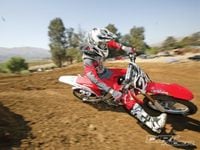

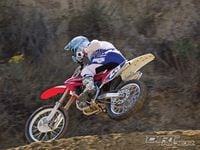
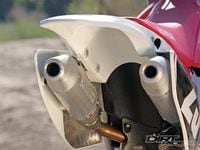
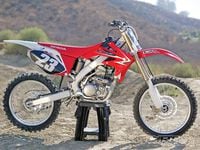
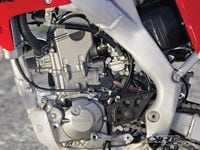
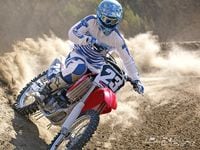
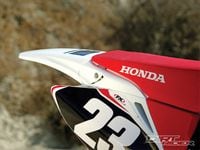
/cloudfront-us-east-1.images.arcpublishing.com/octane/WOYUZXUAMBCZZJ3BQWOEQJGR5M.jpg)
/cloudfront-us-east-1.images.arcpublishing.com/octane/OBHVYZHWBBAZTALZA4GC5RM5WA.jpg)
/cloudfront-us-east-1.images.arcpublishing.com/octane/ZJPPRO5CRNFYPEVMWIFR7RRFQQ.jpg)
/cloudfront-us-east-1.images.arcpublishing.com/octane/MMAOLEHZG5CBXAOICNKNGCEK4I.jpg)
/cloudfront-us-east-1.images.arcpublishing.com/octane/KQUVDTNB6VF53CRDNN47BE3VUA.jpg)
/cloudfront-us-east-1.images.arcpublishing.com/octane/3T32INAZQRGPXOGGA36NQJDSSM.jpg)
/cloudfront-us-east-1.images.arcpublishing.com/octane/EPLS5PBKXBHNXK7S5O7G4ND3YQ.jpg)
/cloudfront-us-east-1.images.arcpublishing.com/octane/MNGOZAGZFZBH5DPFV7NOPF5S3Y.jpg)
/cloudfront-us-east-1.images.arcpublishing.com/octane/VGJWIIFM2VBCXG34KRQ37GCP7U.jpg)
/cloudfront-us-east-1.images.arcpublishing.com/octane/2ZU3HXRPMZESJF7HDLZJV7FHEY.jpg)
/cloudfront-us-east-1.images.arcpublishing.com/octane/VVFWQBZEIZDVJHZIW5ISKWKOZU.jpg)
/cloudfront-us-east-1.images.arcpublishing.com/octane/7T7FZXHIIBDX7AOBD5S3IICUJI.jpg)
/cloudfront-us-east-1.images.arcpublishing.com/octane/T3Y7A52TXBEBJNEPGOQSVPQSPU.jpg)
/cloudfront-us-east-1.images.arcpublishing.com/octane/KY33U3WBTNFIBJFMTEF2SM7BOQ.jpg)
/cloudfront-us-east-1.images.arcpublishing.com/octane/JNPS5MGVXJC7BARVMARYQIQHXE.jpg)
/cloudfront-us-east-1.images.arcpublishing.com/octane/63N2P6SYAZDURJDO5KARQYX2J4.jpg)
/cloudfront-us-east-1.images.arcpublishing.com/octane/C72WX35SXFETTO5OVA2RWT523I.jpg)
/cloudfront-us-east-1.images.arcpublishing.com/octane/F3ER37EV2RGY5CRYFNTWE3JSF4.jpg)
/cloudfront-us-east-1.images.arcpublishing.com/octane/L65QCUR32RH2NKCUHXYHHAPDFI.jpg)
/cloudfront-us-east-1.images.arcpublishing.com/octane/VSK246VVRRDMBNQU7B2NTNY6AE.jpg)
/cloudfront-us-east-1.images.arcpublishing.com/octane/CG64RRFAYRENNAP2AA22T2LSJY.jpg)
/cloudfront-us-east-1.images.arcpublishing.com/octane/IKZSRLBWMRDORMORBXSISL4D6M.jpg)
/cloudfront-us-east-1.images.arcpublishing.com/octane/BJLVRPJSDFC3ZLPMW3LYYHMPZE.jpg)
/cloudfront-us-east-1.images.arcpublishing.com/octane/RQW2RFU4MJDYRPVFJNW362SEXU.jpg)